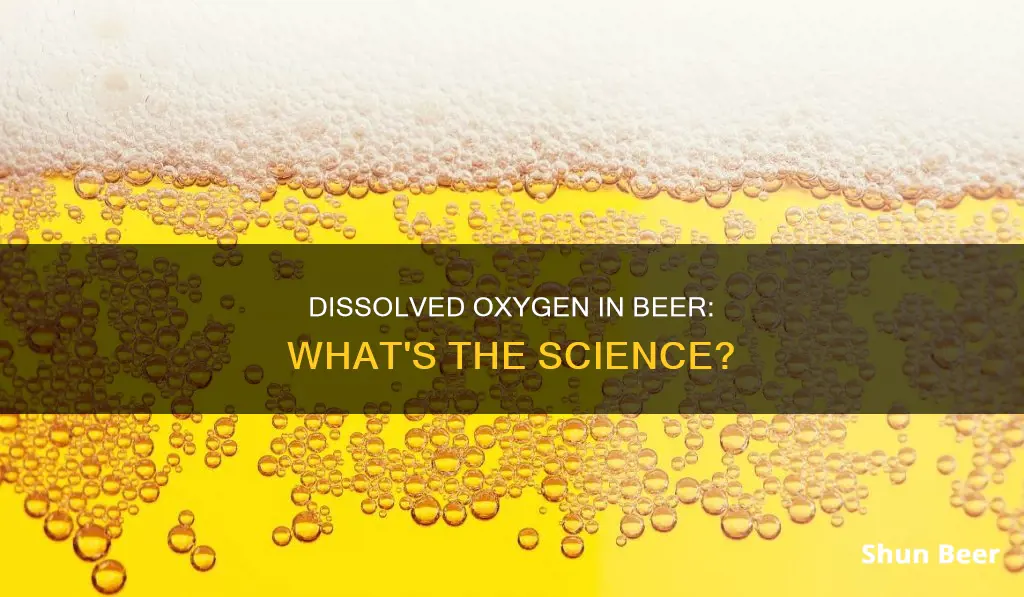
Dissolved oxygen (DO) is a crucial aspect of the beer-making process, with brewers needing to manage the right amount of oxygen to ensure a tasty final product. DO refers to the amount of oxygen dissolved in the water, which is separate from the oxygen that exists in water molecules. It is important to monitor DO levels as it is integral to two core aspects of the beer-making process: fermentation and the finished product.
| Characteristics | Values |
|---|---|
| Purpose of testing dissolved oxygen | To ensure sufficient oxygen is dissolved in wort to initiate fermentation and to prevent staling |
| Dissolved oxygen definition | The amount of oxygen that has been dissolved in the water |
| Dissolved oxygen levels during fermentation | 8-12 PPM; 5 PPM is the lowest for yeast to grow correctly; 17 PPM is the maximum |
| High-gravity brewing dissolved oxygen levels | 15-17 PPM |
| Yeast addition | After the wort has been boiled and cooled |
| Oxygenation of wort | With sterile air after cooling to increase oxygen solubility and reduce wort oxidation; alternatively, oxygenate with hot wort to sterilize the air, but this can cause a garlicky taste |
| Effects of too little dissolved oxygen | Low and sticky fermentation; low ester/alcohol production |
| Effects of too much dissolved oxygen | Rapid fermentation and excessive yeast growth; high ester production and a fruity-tasting beer |
| Factors affecting dissolved oxygen levels | Bright tank DO values; leaks in hoses connected to the bright tank; surrounding temperature; exposure to air |
| Preventing oxidation | Implement a foam cap; minimise exposure to air during packaging; purge brite tank with CO2 |
What You'll Learn
- Yeast needs oxygen to breathe and thrive during fermentation
- Oxygen is the enemy of bottled beer
- Dissolved oxygen (DO) is measured to ensure sufficient oxygen for fermentation
- DO is measured to ensure a low enough level in packaged beer to prevent staling?
- Purging procedures for the brite tank can help avoid oxidation

Yeast needs oxygen to breathe and thrive during fermentation
Yeast is an essential ingredient in the beer-making process. It is responsible for fermentation, which gives beer its carbonation and alcohol content. During fermentation, yeast needs oxygen to breathe and thrive. This process is called respiration, and it is necessary for the survival of the yeast cells.
Oxygen plays a crucial role in yeast metabolism. It is involved in the biosynthesis of unsaturated fatty acids and ergosterol, which are required for adequate anaerobic growth during fermentation. Yeast cells need sterols and unsaturated fatty acids to maintain the proper structure and function of their membranes. If there is a lack of oxygen, the synthesis of these essential compounds can be impaired, leading to alterations in the yeast membrane structure and suboptimal function of membrane-linked processes.
Additionally, yeast cells take up oxygen and utilise it in various cellular processes, such as mitochondrial development. However, too much oxygen can be detrimental to yeast, as it can lead to the formation of reactive oxygen species, which are toxic to the cells and can cause degeneration. Therefore, maintaining the right levels of dissolved oxygen during the beer-making process is crucial.
The amount of dissolved oxygen in the wort, which is the sugar solution before fermentation, is particularly important. Wort is typically oxygenated after cooling but before the addition of yeast. This step ensures that the yeast has enough oxygen to grow and carry out fermentation effectively. The optimal level of dissolved oxygen in the wort for fermentation to be successful is between 8 and 12 PPM (parts per million). Below 5 PPM, yeast growth may be impaired, and above 17 PPM, there can be negative consequences for beer production.
It is worth noting that once fermentation begins, the role of oxygen changes. While it is necessary for the initial stages of fermentation, it can become detrimental to the process and the final beer product if it continues to be present. This is because oxygen can lead to oxidation, which negatively affects the flavour, quality, colour, and shelf life of the beer. Therefore, brewers need to carefully manage oxygen levels throughout the brewing process, minimising oxygen exposure after the initial fermentation stage.
The Science Behind Beer Koozies: Do They Really Work?
You may want to see also

Oxygen is the enemy of bottled beer
Oxygen is required during the fermentation process, but once this process is complete, oxygen becomes the enemy of bright and expressive flavours. The presence of oxygen in beer results in oxidation, which negatively impacts the beer's flavour, quality, colour, and shelf life.
Oxygen can enter the beer at various stages of the brewing process. The transfer of beer between tanks, the addition of stabilizers, and the addition of recovered beer can all increase DO levels. Even the exposure of beer to air between cycles can increase DO.
To avoid oxidation, it is important to minimize cold-side transfers, purge lines and target vessels with CO2, and ensure that all joints and unions in the transfer lines are tight. Regularly replacing tri-clamp gaskets and using properly sized Oetiker clamps on hoses can also help to prevent oxygen from entering the beer.
Keeping DO levels low in bottled beer is crucial to maintaining the desired flavour, quality, and shelf life.
The Science Behind Beer Blizzard
You may want to see also

Dissolved oxygen (DO) is measured to ensure sufficient oxygen for fermentation
Dissolved oxygen (DO) is an important factor in the beer-making process. It is required to fuel the yeast during fermentation, but too much DO can lead to an excess of yeast and a loss of usable beer. Therefore, DO is measured to ensure sufficient oxygen for fermentation and to prevent staling.
DO is the amount of oxygen that has been dissolved in the water used in the brewing process. Oxygen is necessary for the survival of yeast, which in turn is needed for the fermentation of wort to produce beer. However, too much oxygen can lead to the formation of compounds that negatively impact the flavour, quality, and colour of the beer. Thus, brewers must carefully monitor and control oxygen levels throughout the brewing process.
During the beer-making process, oxygen is introduced to the wort after boiling and prior to the addition of yeast. This process is called oxygenation or aeration, and it is important for initiating a clean and vigorous fermentation. The majority of breweries oxygenate their wort with sterile air after it has cooled down to increase oxygen solubility and reduce wort oxidation. However, some breweries choose to introduce air while the wort is still hot, which can create a garlicky taste in the final product.
The optimal level of dissolved oxygen in chilled, aerated wort is considered to be around 8 ppm (parts per million). If the level is much lower, the fermentation may become sluggish or stuck, resulting in under-attenuated beer. On the other hand, if the wort is oxygenated to much higher levels, excessive yeast growth can occur, leading to a loss of usable beer volume. Therefore, it is important to monitor and control DO levels to ensure sufficient oxygen for fermentation while also preventing staling and off-flavours.
Underground Beer Coolers: Do They Keep Drinks Chilled?
You may want to see also

DO is measured to ensure a low enough level in packaged beer to prevent staling
Dissolved oxygen (DO) is an important factor in the beer-making process. It is integral to two core aspects of the process: fermentation and the overall quality of the final product.
DO is the amount of oxygen that is incorporated into the liquid during the brewing process. All beer has dissolved oxygen, but the quantity of DO in the beer depends on when and how the beer is handled during and after the fermentation process.
Oxygen is both a friend and foe to brewers. It is necessary for the yeast to breathe and thrive through the fermentation process, but it becomes the enemy of bright and expressive flavours after fermentation. Every process or transfer that beer is subjected to post-fermentation is an opportunity for oxygen to find its way into the beer and begin the process of staling, muting, and reducing shelf life. The packaging process is one step that presents a particular risk. The added oxygen that results from putting beer into cans, kegs, or bottles can impact the quality and taste of the final product.
Therefore, DO is measured to ensure a low enough level in packaged beer to prevent staling. Testing for DO can be challenging, and it is important to maintain a consistent methodology with a focus on results and trends. Once fermentation is complete, there are few ways to reduce DO in beer, but there are many ways to add it. Thus, the first place to measure DO in the process is after primary fermentation, before dry hopping.
To ensure low levels of DO in packaged beer, brewers should monitor several factors. Firstly, the incoming DO level in the bright tank should be as low as possible, as the more DO in the beer before packaging, the more DO in the beer overall. Secondly, leaks in the hoses connected to the bright tank can add oxygen to the beer, so regular manual inspections of the bright tanks are necessary. Thirdly, the surrounding temperature can affect DO levels, and beer should ideally be kept at temperatures around 34°F (1°C) to maintain DO levels and generate sufficient foam when poured. Fourthly, exposure to air during the filling and bottling process can increase DO, so it is crucial to minimise turbulence and maintain smooth operations. Finally, a foam cap is one of the best ways to maintain DO levels, as fill speed, fill volume, and foam can cause high amounts of DO to get into the beer before packaging.
Wet Paper Towel on Beer: Does This Method Work?
You may want to see also

Purging procedures for the brite tank can help avoid oxidation
Purging procedures for the brite tank are essential to avoid oxidation and ensure the quality of the final beer product. Oxidation can lead to undesirable off-flavors in beer, such as acetaldehyde, which can taste like green apple or fresh-cut grass, or trans-2-nonenal, which imparts a flavour reminiscent of old cardboard or wet newspaper.
There are several methods that can be employed to purge a brite tank effectively. One common technique is to use carbon dioxide (CO2) gas, introduced slowly from the bottom of the tank and vented out through the top. This process can take several hours, depending on the size of the tank. It is important to ensure that all valves and lines are open during this procedure. Some brewers recommend pressurising the tank to a certain psi and then venting, repeating this process a few times before final pressurisation and transfer. The specific psi values may vary depending on the equipment and preferences of the brewer.
Another method mentioned is the Weihenstephaner technique, which involves pressurising the tank from the bottom and venting out the top, repeating this process a few times. This technique has been successful for some brewers in reducing dissolved oxygen levels in the brite tank.
For smaller tanks, one effective approach is to use boiled water passed through a heat exchanger, followed by flushing with CO2. This results in a perfectly purged, oxygen-free tank.
Additionally, a Clean In Place (CIP) procedure under pressure may be suitable for larger tanks or when water conservation is a priority. This method keeps the tank closed and utilises CO2 to push the beer out, with specific cleaners suitable for a CO2 environment.
It is worth noting that some brewers question the effectiveness of the "blanket" theory, which suggests that CO2 settles like a blanket, protecting the beer from oxygen ingress. Gases naturally mix over time, and factors like turbulence and temperature can influence this process. Therefore, relying solely on the "blanket" theory may not be sufficient to prevent oxidation.
To ensure the absence of oxygen, it is recommended to use measurement devices or oxygen sensors rather than relying on sensory cues, such as smelling CO2 or the stinging sensation on the nose, as these methods are not accurate or safe.
Overall, establishing a good purging procedure for the brite tank is crucial to prevent oxidation and maintain the desired flavour profile of the beer.
Hand-Pulled Beer Pumps: Traditional, Unique, and Fun!
You may want to see also
Frequently asked questions
Dissolved oxygen is important for the fermentation process, which gives beer its carbonation and alcohol content. It is also necessary for the yeast to survive.
The ideal amount of dissolved oxygen in beer depends on various factors, including the type of beer being brewed, the wort gravity, the yeast strain, and the fermentation temperature. However, generally, dissolved oxygen levels should be around 8-12 PPM for successful fermentation.
Too much dissolved oxygen in beer can cause it to taste stale. It can also lead to the formation of undesirable compounds, such as aldehydes and fatty acids, which can negatively impact the flavour and quality of the beer.







